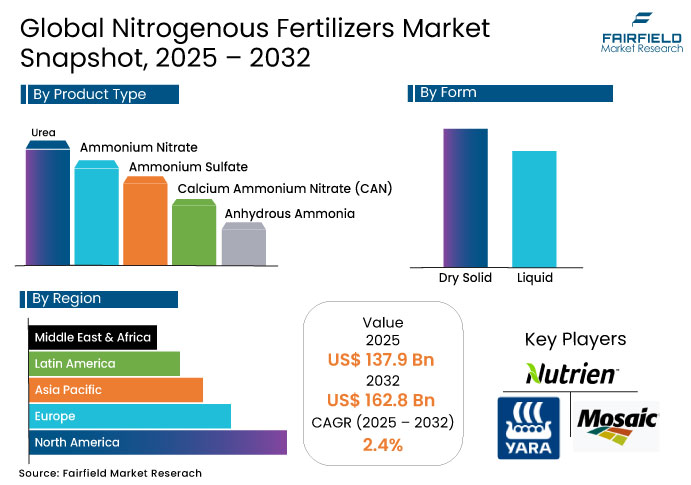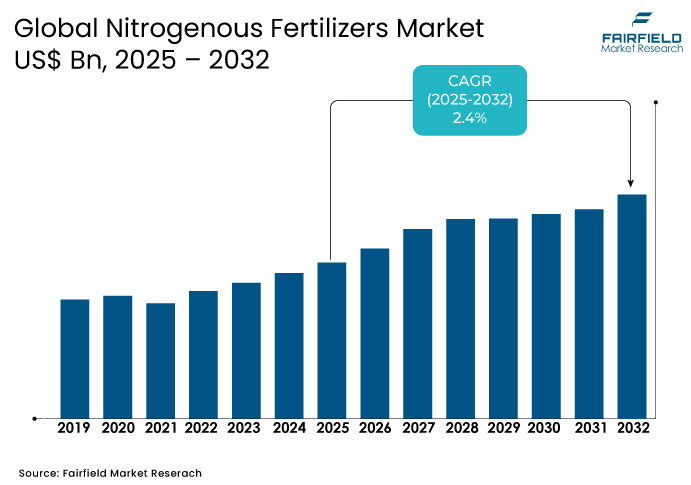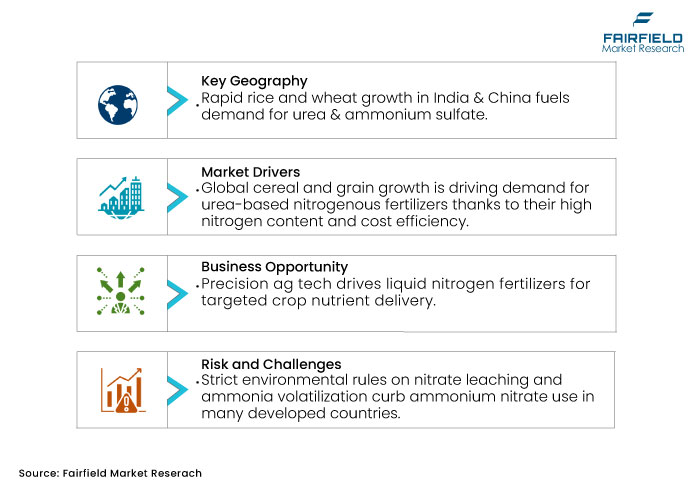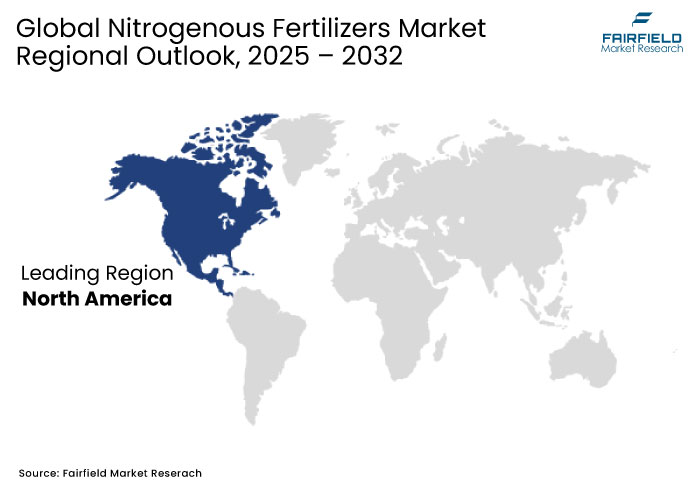Global Nitrogenous Fertilizers Market Forecast
- Global Nitrogenous Fertilizers market is expected to grow from US$ 137.9 Bn in 2025 to US$162.8 Bn by 2032. The market with register a steady CAGR of 2.4% during this period.
- Increasing nutrient depletion in agricultural soils due to intensive farming practices is identified as the key reason for the rising demand for nitrogenous fertilizers.

Nitrogenous Fertilizers Insights
- Urea continues to dominate the market due to its high nitrogen concentration and cost-efficiency, making it the preferred choice for cereal and grain cultivation in Asia and Africa where maximizing yield is critical.
- Liquid nitrogenous fertilizers are gaining traction as they align well with fertigation systems, especially in high-value fruit and vegetable farming, enabling precise nutrient delivery and improved crop health.
- Ammonium sulfate demand is rising in oilseeds and pulses cultivation, particularly in sulfur-deficient soils, as it provides both nitrogen and sulfur needed for protein synthesis and crop growth.
- Dry-form fertilizers remain widely used across smallholder farms in regions like South Asia due to ease of storage, transport, and broadcast application, supported by extensive public distribution systems.
- North America's push for sustainable corn farming is driving adoption of controlled-release and stabilized nitrogen fertilizers, addressing nutrient runoff concerns while maintaining yield and soil health.
A Look Back and a Look Forward - Comparative Analysis
Between 2019 and 2024, the nitrogenous fertilizers market experienced fluctuating demand due to global supply chain disruptions, rising natural gas prices, and COVID-19’s impact on agricultural trade. However, government subsidies, especially in Asia, and the need to boost food security sustained strong usage of urea and ammonium-based fertilizers across key cereal-growing regions.
From 2025 onward, the market is expected to witness transformation driven by precision agriculture, environmental regulations, and adoption of enhanced-efficiency fertilizers. Innovations in green ammonia, controlled-release formulations, and site-specific nutrient application are likely to reshape product portfolios. Growing emphasis on sustainable farming practices and digital integration will further redefine competitive strategies and regional consumption patterns.
Key Growth Determinants
Rising global cereal and grain production is boosting the demand for urea-based nitrogenous fertilizers due to their high nitrogen content and cost-effectiveness
Global cereal and grain production continues to surge, directly boosting demand for urea-based nitrogen fertilizers. Cereals alone consume nearly 50% of total global fertilizer use—led by maize, wheat, and rice—highlighting their central role in driving nitrogen demand. As cereal output increases across Asia, Africa, and Latin America, farmers consistently prefer urea due to its high nitrogen content and affordability, making it the most widely applied nitrogenous fertilizer.
The trend is reinforced by recent market developments. For instance, QatarEnergy has announced a major expansion in urea production capacity to over 12.4 million tonnes annually to meet rising global food demand. In India, urea consumption rose to approximately 38.8 million tonnes in 2024–25, supported by government subsidies and the push for higher grain yields. These examples highlight how expanding cereal and grain production is driving long-term growth in the nitrogenous fertilizers market.

Key Growth Barriers
Stringent environmental regulations on nitrate leaching and ammonia volatilization are limiting the widespread usage of ammonium nitrate in several developed countries
Environmental regulations targeting nitrate leaching are increasingly limiting ammonium nitrate usage. The European Union’s Nitrates Directive, for instance, designates large agricultural zones as vulnerable, enforcing strict limits on the timing and quantity of nitrogen fertilizer applications to prevent groundwater nitrate contamination. These restrictions are making it difficult for farmers to rely on ammonium nitrate, prompting a shift toward more regulated and complex nutrient management systems.
Likewise, concerns around ammonia volatilization are leading to tighter regulatory controls on ammonium-based fertilizers. Surface-applied ammonium nitrate can result in nitrogen losses of up to 30% due to volatilization, contributing to air quality degradation and reduced fertilizer efficiency. As a result, many farmers and fertilizer producers are transitioning toward stabilized or alternative nitrogen products, reducing the widespread use of conventional ammonium nitrate in developed markets.
Nitrogenous Fertilizers Market Opportunities
Expansion of precision agriculture technologies is creating opportunities for liquid-form nitrogenous fertilizers that allow controlled, crop-specific nutrient delivery
The expansion of precision agriculture technologies is creating significant opportunities for liquid-form nitrogenous fertilizers by enabling accurate, crop-specific nutrient application. Liquid fertilizers such as UAN (urea ammonium nitrate) integrate seamlessly with modern systems like variable-rate applicators, fertigation setups, and sensor-based tools, allowing farmers to deliver nutrients based on real-time soil and crop conditions for maximum efficiency and productivity.
Leading agribusinesses are capitalizing on this trend by investing in advanced liquid fertilizer solutions tailored to precision farming needs. Companies like Nutrien and Yara have expanded their liquid fertilizer offerings in regions with strong adoption of digital agriculture. As farming practices shift toward sustainability and resource optimization, liquid nitrogenous fertilizers market are becoming a key enabler of precision farming, driving their growing relevance in the global market.

Segment-wise Overview
- The liquid nitrogenous fertilizer segment is gaining momentum due to its compatibility with fertigation systems in high-value horticulture crops like fruits and vegetables
Liquid-form nitrogenous fertilizers, particularly urea ammonium nitrate solutions, are gaining significant momentum due to their compatibility with fertigation systems used in horticulture. Approximately 39% of liquid fertilizer applications globally are facilitated through fertigation, especially in high-value fruit and vegetable crops. This approach enables precise nutrient delivery to plant roots, enhancing nutrient use efficiency and improving both yield and quality.
Major agribusinesses are expanding their liquid fertilizer portfolios to serve the growing horticulture market. Companies like Nutrien and Yara are targeting greenhouse growers and drip-irrigated orchards with tailored liquid nitrogen products. As advanced irrigation systems gain popularity and farmers aim to reduce nutrient losses, liquid nitrogenous fertilizers are becoming the preferred choice; positioning this segment as a major driver of nitrogenous fertilizers market growth.
- Urea remains the dominant product due to its high nitrogen content, with innovations in stabilized and coated formulations driving sustained usage
Urea remains the dominant nitrogen fertilizer due to its high nitrogen content, approximately 46%, and its cost-effectiveness for farmers worldwide. Its versatility and ease of storage and application make it particularly suitable for staple crops such as corn, wheat, and rice. Urea accounts for more than half of global nitrogen fertilizer usage, reaffirming its essential role in modern agriculture.
Recent innovations in stabilized and coated urea products are reinforcing its market leadership. For example, enhanced efficiency formulations like sulfur-coated and polymer-coated urea are helping reduce nitrogen loss through volatilization and leaching. These products not only increase nutrient use efficiency but also support environmental compliance, making urea an increasingly attractive choice amid growing focus on sustainable farming practices.
Regional Analysis
- In North America, increasing adoption of controlled-release urea fertilizers is addressing concerns of nutrient runoff and improving nitrogen-use efficiency in corn cultivation
Adoption of controlled-release urea fertilizers (CRU) is gaining momentum in North America’s corn belt, addressing nutrient runoff and enhancing nitrogen-use efficiency. Field studies indicate that CRU can boost corn yields by 9–11% and improve nitrogen-use efficiency by around 11%, while reducing nitrogen losses by up to 30% compared to conventional urea applications.
Agribusinesses like Nutrien, Yara, and ICL are expanding offerings of polymer-coated urea and customized nitrogen blends to meet growing sustainability demands. Trials have shown that CRU allows farmers to maintain yields with up to 30% less nitrogen input, reducing application frequency and environmental impact. This shift is placing North America at the forefront of innovation in precision nutrient management.

- Europe is witnessing growing demand for calcium ammonium nitrate as a safer alternative to ammonium nitrate, driven by sustainability goals and regulatory compliance
Europe is witnessing rising demand for calcium ammonium nitrate (CAN) as a safer and more environmentally responsible alternative to ammonium nitrate. Stringent EU regulations on explosive precursors and nitrate leaching have made CAN more favorable for farmers. In countries like Germany and France, CAN is preferred due to its lower environmental risk and better compatibility with sustainable agriculture practices.
The European Green Deal and Farm to Fork Strategy are pushing for reduced emissions and improved soil health, further encouraging the adoption of CAN. Major producers such as Yara and EuroChem have increased investments in stabilized CAN formulations to align with EU policy objectives. As farmers seek products that balance productivity with compliance, CAN continues to gain ground across European farmlands, driving regional nitrogenous fertilizers market growth.
- Rapid expansion of rice and wheat farming in countries like India and China continues to drive strong demand for dry granular urea and ammonium sulfate fertilizers
The Asia Pacific region’s demand for nitrogenous fertilizers is strongly fueled by expanding rice and wheat cultivation, particularly in China and India. For instance, China cultivated over 23 million hectares of wheat and nearly 30 million hectares of rice in recent years, requiring sustained nitrogen inputs like ammonium sulfate. Ammonium sulfate is widely used for its sulfur-nitrogen dual benefits, crucial for soil health and crop protein content.
India’s rice production crossed 130 million metric tons recently, driving the use of dry granular fertilizers compatible with traditional flood irrigation. Ammonium sulfate plays a key role in acidic and sulfur-deficient soils common in Eastern India and Southern China. With governments supporting nutrient-balanced fertilization and higher yield targets, the strong reliance on ammonium sulfate and other granular forms is expected to maintain Asia Pacific's leadership in nitrogenous fertilizer consumption.
Fairfield’s Competitive Landscape Analysis
The competitive landscape of the nitrogenous fertilizers market is marked by strategic expansion, product innovation, and supply chain integration. Key players are focusing on backward integration into ammonia production, development of stabilized and controlled-release formulations, and investment in green ammonia to align with climate targets. These moves are reshaping traditional value chains and increasing competitiveness across regions.
Companies are also leveraging digital agriculture platforms and precision farming partnerships to create bundled offerings that improve fertilizer use efficiency and customer retention. Recent investments in low-emission technologies and partnerships for sustainable nitrogen production are intensifying the race to lead in environmentally compliant solutions. This shift toward differentiated, high-performance nitrogen products is driving consolidation and innovation across the global market.
Key Companies
- The Mosaic Company
- Yara International ASA
- Nutrien Ltd.
- OCI Nitrogen
- Koch Industries
- Eurochem Group
- Cargill
- CF Industries Holdings Inc.
- ICL Fertilizers
- Bunge Ltd.
- PJSC Togliattiazot
- Triomf SA
- Omnia Holdings Limited
- Sorfert
- Coromandel International Ltd.
An Expert’s Eye
- Rising global food demand is reinforcing the importance of nitrogenous fertilizers, with urea and ammonium-based variants remaining essential for maximizing yield in staple crops like rice and wheat.
- Environmental regulations are pushing the industry toward enhanced efficiency products such as coated and stabilized fertilizers that reduce nitrogen loss, volatilization, and leaching into water bodies.
- Integration of precision agriculture technologies is enabling optimized nutrient application, creating future demand for liquid and specialty nitrogen fertilizers tailored to crop-specific and soil-specific needs.
- Volatility in natural gas prices poses a risk to profitability, prompting producers to diversify sourcing and invest in green ammonia technologies.
Global Nitrogenous Fertilizers Market Segmentation-
By Product Type
- Urea
- Ammonium Nitrate
- Ammonium Sulfate
- Calcium Ammonium Nitrate (CAN)
- Anhydrous Ammonia
- Others (Urea Ammonium Nitrate, etc.)
By Form
- Dry Solid
- Liquid
By Crop Type
- Cereals & Grains
- Oilseeds & Pulses
- Fruits & Vegetables
- Others
By Region
- North America
- Europe
- Asia Pacific
- Latin America
- Middle East & Africa
1. Executive Summary
1.1. Global Nitrogenous Fertilizers Snapshot
1.2. Future Projections
1.3. Key Market Trends
1.4. Regional Snapshot, by Value, 2025
1.5. Analyst Recommendations
2. Market Overview
2.1. Market Definitions and Segmentations
2.2. Market Dynamics
2.2.1. Drivers
2.2.2. Restraints
2.2.3. Market Opportunities
2.3. Value Chain Analysis
2.4. COVID-19 Impact Analysis
2.5. Porter's Fiver Forces Analysis
2.6. Impact of Russia-Ukraine Conflict
2.7. PESTLE Analysis
2.8. Regulatory Analysis
2.9. Price Trend Analysis
2.9.1. Current Prices and Future Projections, 2024-2032
2.9.2. Price Impact Factors
3. Global Nitrogenous Fertilizers Outlook, 2019 - 2032
3.1. Global Nitrogenous Fertilizers Outlook, by Product Type, Value (US$ Bn) & Volume (Tons), 2019 - 2032
3.1.1. Urea
3.1.2. Ammonium Nitrate
3.1.3. Ammonium Sulfate
3.1.4. Calcium Ammonium Nitrate (CAN)
3.1.5. Anhydrous Ammonia
3.1.6. Others (Urea Ammonium Nitrate, etc.)
3.2. Global Nitrogenous Fertilizers Outlook, by Form, Value (US$ Bn) & Volume (Tons), 2019 - 2032
3.2.1. Dry Solid
3.2.2. Liquid
3.3. Global Nitrogenous Fertilizers Outlook, by Crop Type, Value (US$ Bn) & Volume (Tons), 2019 - 2032
3.3.1. Cereals & Grains
3.3.2. Oilseeds & Pulses
3.3.3. Fruits & Vegetables
3.3.4. Others
3.4. Global Nitrogenous Fertilizers Outlook, by Region, Value (US$ Bn) & Volume (Tons), 2019 - 2032
3.4.1. North America
3.4.2. Europe
3.4.3. Asia Pacific
3.4.4. Latin America
3.4.5. Middle East & Africa
4. North America Nitrogenous Fertilizers Outlook, 2019 - 2032
4.1. North America Nitrogenous Fertilizers Outlook, by Product Type, Value (US$ Bn) & Volume (Tons), 2019 - 2032
4.1.1. Urea
4.1.2. Ammonium Nitrate
4.1.3. Ammonium Sulfate
4.1.4. Calcium Ammonium Nitrate (CAN)
4.1.5. Anhydrous Ammonia
4.1.6. Others (Urea Ammonium Nitrate, etc.)
4.2. North America Nitrogenous Fertilizers Outlook, by Form, Value (US$ Bn) & Volume (Tons), 2019 - 2032
4.2.1. Dry Solid
4.2.2. Liquid
4.3. North America Nitrogenous Fertilizers Outlook, by Crop Type, Value (US$ Bn) & Volume (Tons), 2019 - 2032
4.3.1. Cereals & Grains
4.3.2. Oilseeds & Pulses
4.3.3. Fruits & Vegetables
4.3.4. Others
4.4. North America Nitrogenous Fertilizers Outlook, by Country, Value (US$ Bn) & Volume (Tons), 2019 - 2032
4.4.1. U.S. Nitrogenous Fertilizers Outlook, by Product Type, 2019 - 2032
4.4.2. U.S. Nitrogenous Fertilizers Outlook, by Form, 2019 - 2032
4.4.3. U.S. Nitrogenous Fertilizers Outlook, by Crop Type, 2019 - 2032
4.4.4. Canada Nitrogenous Fertilizers Outlook, by Product Type, 2019 - 2032
4.4.5. Canada Nitrogenous Fertilizers Outlook, by Form, 2019 - 2032
4.4.6. Canada Nitrogenous Fertilizers Outlook, by Crop Type, 2019 - 2032
4.5. BPS Analysis/Market Attractiveness Analysis
5. Europe Nitrogenous Fertilizers Outlook, 2019 - 2032
5.1. Europe Nitrogenous Fertilizers Outlook, by Product Type, Value (US$ Bn) & Volume (Tons), 2019 - 2032
5.1.1. Urea
5.1.2. Ammonium Nitrate
5.1.3. Ammonium Sulfate
5.1.4. Calcium Ammonium Nitrate (CAN)
5.1.5. Anhydrous Ammonia
5.1.6. Others (Urea Ammonium Nitrate, etc.)
5.2. Europe Nitrogenous Fertilizers Outlook, by Form, Value (US$ Bn) & Volume (Tons), 2019 - 2032
5.2.1. Dry Solid
5.2.2. Liquid
5.3. Europe Nitrogenous Fertilizers Outlook, by Crop Type, Value (US$ Bn) & Volume (Tons), 2019 - 2032
5.3.1. Cereals & Grains
5.3.2. Oilseeds & Pulses
5.3.3. Fruits & Vegetables
5.3.4. Others
5.4. Europe Nitrogenous Fertilizers Outlook, by Country, Value (US$ Bn) & Volume (Tons), 2019 - 2032
5.4.1. Germany Nitrogenous Fertilizers Outlook, by Product Type, 2019 - 2032
5.4.2. Germany Nitrogenous Fertilizers Outlook, by Form, 2019 - 2032
5.4.3. Germany Nitrogenous Fertilizers Outlook, by Crop Type, 2019 - 2032
5.4.4. Italy Nitrogenous Fertilizers Outlook, by Product Type, 2019 - 2032
5.4.5. Italy Nitrogenous Fertilizers Outlook, by Form, 2019 - 2032
5.4.6. Italy Nitrogenous Fertilizers Outlook, by Crop Type, 2019 - 2032
5.4.7. France Nitrogenous Fertilizers Outlook, by Product Type, 2019 - 2032
5.4.8. France Nitrogenous Fertilizers Outlook, by Form, 2019 - 2032
5.4.9. France Nitrogenous Fertilizers Outlook, by Crop Type, 2019 - 2032
5.4.10. U.K. Nitrogenous Fertilizers Outlook, by Product Type, 2019 - 2032
5.4.11. U.K. Nitrogenous Fertilizers Outlook, by Form, 2019 - 2032
5.4.12. U.K. Nitrogenous Fertilizers Outlook, by Crop Type, 2019 - 2032
5.4.13. Spain Nitrogenous Fertilizers Outlook, by Product Type, 2019 - 2032
5.4.14. Spain Nitrogenous Fertilizers Outlook, by Form, 2019 - 2032
5.4.15. Spain Nitrogenous Fertilizers Outlook, by Crop Type, 2019 - 2032
5.4.16. Russia Nitrogenous Fertilizers Outlook, by Product Type, 2019 - 2032
5.4.17. Russia Nitrogenous Fertilizers Outlook, by Form, 2019 - 2032
5.4.18. Russia Nitrogenous Fertilizers Outlook, by Crop Type, 2019 - 2032
5.4.19. Rest of Europe Nitrogenous Fertilizers Outlook, by Product Type, 2019 - 2032
5.4.20. Rest of Europe Nitrogenous Fertilizers Outlook, by Form, 2019 - 2032
5.4.21. Rest of Europe Nitrogenous Fertilizers Outlook, by Crop Type, 2019 - 2032
5.5. BPS Analysis/Market Attractiveness Analysis
6. Asia Pacific Nitrogenous Fertilizers Outlook, 2019 - 2032
6.1. Asia Pacific Nitrogenous Fertilizers Outlook, by Product Type, Value (US$ Bn) & Volume (Tons), 2019 - 2032
6.1.1. Urea
6.1.2. Ammonium Nitrate
6.1.3. Ammonium Sulfate
6.1.4. Calcium Ammonium Nitrate (CAN)
6.1.5. Anhydrous Ammonia
6.1.6. Others (Urea Ammonium Nitrate, etc.)
6.2. Asia Pacific Nitrogenous Fertilizers Outlook, by Form, Value (US$ Bn) & Volume (Tons), 2019 - 2032
6.2.1. Dry Solid
6.2.2. Liquid
6.3. Asia Pacific Nitrogenous Fertilizers Outlook, by Crop Type, Value (US$ Bn) & Volume (Tons), 2019 - 2032
6.3.1. Cereals & Grains
6.3.2. Oilseeds & Pulses
6.3.3. Fruits & Vegetables
6.3.4. Others
6.4. Asia Pacific Nitrogenous Fertilizers Outlook, by Country, Value (US$ Bn) & Volume (Tons), 2019 - 2032
6.4.1. China Nitrogenous Fertilizers Outlook, by Product Type, 2019 - 2032
6.4.2. China Nitrogenous Fertilizers Outlook, by Form, 2019 - 2032
6.4.3. China Nitrogenous Fertilizers Outlook, by Crop Type, 2019 - 2032
6.4.4. Japan Nitrogenous Fertilizers Outlook, by Product Type, 2019 - 2032
6.4.5. Japan Nitrogenous Fertilizers Outlook, by Form, 2019 - 2032
6.4.6. Japan Nitrogenous Fertilizers Outlook, by Crop Type, 2019 - 2032
6.4.7. South Korea Nitrogenous Fertilizers Outlook, by Product Type, 2019 - 2032
6.4.8. South Korea Nitrogenous Fertilizers Outlook, by Form, 2019 - 2032
6.4.9. South Korea Nitrogenous Fertilizers Outlook, by Crop Type, 2019 - 2032
6.4.10. India Nitrogenous Fertilizers Outlook, by Product Type, 2019 - 2032
6.4.11. India Nitrogenous Fertilizers Outlook, by Form, 2019 - 2032
6.4.12. India Nitrogenous Fertilizers Outlook, by Crop Type, 2019 - 2032
6.4.13. Southeast Asia Nitrogenous Fertilizers Outlook, by Product Type, 2019 - 2032
6.4.14. Southeast Asia Nitrogenous Fertilizers Outlook, by Form, 2019 - 2032
6.4.15. Southeast Asia Nitrogenous Fertilizers Outlook, by Crop Type, 2019 - 2032
6.4.16. Rest of SAO Nitrogenous Fertilizers Outlook, by Product Type, 2019 - 2032
6.4.17. Rest of SAO Nitrogenous Fertilizers Outlook, by Form, 2019 - 2032
6.4.18. Rest of SAO Nitrogenous Fertilizers Outlook, by Crop Type, 2019 - 2032
6.5. BPS Analysis/Market Attractiveness Analysis
7. Latin America Nitrogenous Fertilizers Outlook, 2019 - 2032
7.1. Latin America Nitrogenous Fertilizers Outlook, by Product Type, Value (US$ Bn) & Volume (Tons), 2019 - 2032
7.1.1. Urea
7.1.2. Ammonium Nitrate
7.1.3. Ammonium Sulfate
7.1.4. Calcium Ammonium Nitrate (CAN)
7.1.5. Anhydrous Ammonia
7.1.6. Others (Urea Ammonium Nitrate, etc.)
7.2. Latin America Nitrogenous Fertilizers Outlook, by Form, Value (US$ Bn) & Volume (Tons), 2019 - 2032
7.2.1. Dry Solid
7.2.2. Liquid
7.3. Latin America Nitrogenous Fertilizers Outlook, by Crop Type, Value (US$ Bn) & Volume (Tons), 2019 - 2032
7.3.1. Cereals & Grains
7.3.2. Oilseeds & Pulses
7.3.3. Fruits & Vegetables
7.3.4. Others
7.4. Latin America Nitrogenous Fertilizers Outlook, by Country, Value (US$ Bn) & Volume (Tons), 2019 - 2032
7.4.1. Brazil Nitrogenous Fertilizers Outlook, by Product Type, 2019 - 2032
7.4.2. Brazil Nitrogenous Fertilizers Outlook, by Form, 2019 - 2032
7.4.3. Brazil Nitrogenous Fertilizers Outlook, by Crop Type, 2019 - 2032
7.4.4. Mexico Nitrogenous Fertilizers Outlook, by Product Type, 2019 - 2032
7.4.5. Mexico Nitrogenous Fertilizers Outlook, by Form, 2019 - 2032
7.4.6. Mexico Nitrogenous Fertilizers Outlook, by Crop Type, 2019 - 2032
7.4.7. Argentina Nitrogenous Fertilizers Outlook, by Product Type, 2019 - 2032
7.4.8. Argentina Nitrogenous Fertilizers Outlook, by Form, 2019 - 2032
7.4.9. Argentina Nitrogenous Fertilizers Outlook, by Crop Type, 2019 - 2032
7.4.10. Rest of LATAM Nitrogenous Fertilizers Outlook, by Product Type, 2019 - 2032
7.4.11. Rest of LATAM Nitrogenous Fertilizers Outlook, by Form, 2019 - 2032
7.4.12. Rest of LATAM Nitrogenous Fertilizers Outlook, by Crop Type, 2019 - 2032
7.5. BPS Analysis/Market Attractiveness Analysis
8. Middle East & Africa Nitrogenous Fertilizers Outlook, 2019 - 2032
8.1. Middle East & Africa Nitrogenous Fertilizers Outlook, by Product Type, Value (US$ Bn) & Volume (Tons), 2019 - 2032
8.1.1. Urea
8.1.2. Ammonium Nitrate
8.1.3. Ammonium Sulfate
8.1.4. Calcium Ammonium Nitrate (CAN)
8.1.5. Anhydrous Ammonia
8.1.6. Others (Urea Ammonium Nitrate, etc.)
8.2. Middle East & Africa Nitrogenous Fertilizers Outlook, by Form, Value (US$ Bn) & Volume (Tons), 2019 - 2032
8.2.1. Dry Solid
8.2.2. Liquid
8.3. Middle East & Africa Nitrogenous Fertilizers Outlook, by Crop Type, Value (US$ Bn) & Volume (Tons), 2019 - 2032
8.3.1. Cereals & Grains
8.3.2. Oilseeds & Pulses
8.3.3. Fruits & Vegetables
8.3.4. Others
8.4. Middle East & Africa Nitrogenous Fertilizers Outlook, by Country, Value (US$ Bn) & Volume (Tons), 2019 - 2032
8.4.1. GCC Nitrogenous Fertilizers Outlook, by Product Type, 2019 - 2032
8.4.2. GCC Nitrogenous Fertilizers Outlook, by Form, 2019 - 2032
8.4.3. GCC Nitrogenous Fertilizers Outlook, by Crop Type, 2019 - 2032
8.4.4. South Africa Nitrogenous Fertilizers Outlook, by Product Type, 2019 - 2032
8.4.5. South Africa Nitrogenous Fertilizers Outlook, by Form, 2019 - 2032
8.4.6. South Africa Nitrogenous Fertilizers Outlook, by Crop Type, 2019 - 2032
8.4.7. Egypt Nitrogenous Fertilizers Outlook, by Product Type, 2019 - 2032
8.4.8. Egypt Nitrogenous Fertilizers Outlook, by Form, 2019 - 2032
8.4.9. Egypt Nitrogenous Fertilizers Outlook, by Crop Type, 2019 - 2032
8.4.10. Nigeria Nitrogenous Fertilizers Outlook, by Product Type, 2019 - 2032
8.4.11. Nigeria Nitrogenous Fertilizers Outlook, by Form, 2019 - 2032
8.4.12. Nigeria Nitrogenous Fertilizers Outlook, by Crop Type, 2019 - 2032
8.4.13. Rest of Middle East Nitrogenous Fertilizers Outlook, by Product Type, 2019 - 2032
8.4.14. Rest of Middle East Nitrogenous Fertilizers Outlook, by Form, 2019 - 2032
8.4.15. Rest of Middle East Nitrogenous Fertilizers Outlook, by Crop Type, 2019 - 2032
8.5. BPS Analysis/Market Attractiveness Analysis
9. Competitive Landscape
9.1. Company Vs Segment Heatmap
9.2. Company Market Share Analysis, 2024
9.3. Competitive Dashboard
9.4. Company Profiles
9.4.1. The Mosaic Company
9.4.1.1. Company Overview
9.4.1.2. Product Portfolio
9.4.1.3. Financial Overview
9.4.1.4. Business Strategies and Developments
9.4.2. Yara International ASA
9.4.2.1. Company Overview
9.4.2.2. Product Portfolio
9.4.2.3. Financial Overview
9.4.2.4. Business Strategies and Developments
9.4.3. Nutrien Ltd.
9.4.3.1. Company Overview
9.4.3.2. Product Portfolio
9.4.3.3. Financial Overview
9.4.3.4. Business Strategies and Developments
9.4.4. OCI Nitrogen
9.4.4.1. Company Overview
9.4.4.2. Product Portfolio
9.4.4.3. Financial Overview
9.4.4.4. Business Strategies and Developments
9.4.5. Koch Industries
9.4.5.1. Company Overview
9.4.5.2. Product Portfolio
9.4.5.3. Financial Overview
9.4.5.4. Business Strategies and Developments
9.4.6. Eurochem Group
9.4.6.1. Company Overview
9.4.6.2. Product Portfolio
9.4.6.3. Financial Overview
9.4.6.4. Business Strategies and Developments
9.4.7. Cargill
9.4.7.1. Company Overview
9.4.7.2. Product Portfolio
9.4.7.3. Financial Overview
9.4.7.4. Business Strategies and Developments
9.4.8. CF Industries Holdings Inc.
9.4.8.1. Company Overview
9.4.8.2. Product Portfolio
9.4.8.3. Financial Overview
9.4.8.4. Business Strategies and Developments
9.4.9. ICL Fertilizers
9.4.9.1. Company Overview
9.4.9.2. Product Portfolio
9.4.9.3. Financial Overview
9.4.9.4. Business Strategies and Developments
9.4.10. Bunge Ltd.
9.4.10.1. Company Overview
9.4.10.2. Product Portfolio
9.4.10.3. Financial Overview
9.4.10.4. Business Strategies and Developments
9.4.11. PJSC Togliattiazot
9.4.11.1. Company Overview
9.4.11.2. Product Portfolio
9.4.11.3. Financial Overview
9.4.11.4. Business Strategies and Developments
9.4.12. Triomf SA
9.4.12.1. Company Overview
9.4.12.2. Product Portfolio
9.4.12.3. Financial Overview
9.4.12.4. Business Strategies and Developments
9.4.13. Omnia Holdings Limited
9.4.13.1. Company Overview
9.4.13.2. Product Portfolio
9.4.13.3. Financial Overview
9.4.13.4. Business Strategies and Developments
9.4.14. Sorfert
9.4.14.1. Company Overview
9.4.14.2. Product Portfolio
9.4.14.3. Financial Overview
9.4.14.4. Business Strategies and Developments
9.4.15. Coromandel International Ltd.
9.4.15.1. Company Overview
9.4.15.2. Product Portfolio
9.4.15.3. Financial Overview
9.4.15.4. Business Strategies and Developments
10. Appendix
10.1. Research Methodology
10.2. Report Assumptions
10.3. Acronyms and Abbreviations
|
BASE YEAR |
HISTORICAL DATA |
FORECAST PERIOD |
UNITS |
|||
|
2024 |
|
2019 - 2024 |
2025 - 2032 |
Value: US$ Million |
||
|
REPORT FEATURES |
DETAILS |
|
Product Type Coverage |
|
|
Form Coverage |
|
|
Crop Type |
|
|
Geographical Coverage |
|
|
Leading Companies |
|
|
Report Highlights |
Key Market Indicators, Macro-micro economic impact analysis, Technological Roadmap, Key Trends, Driver, Restraints, and Future Opportunities & Revenue Pockets, Porter’s 5 Forces Analysis, Historical Trend (2019-2024), Market Estimates and Forecast, Market Dynamics, Industry Trends, Competition Landscape, Category, Region, Country-wise Trends & Analysis, COVID-19 Impact Analysis (Demand and Supply Chain) |
